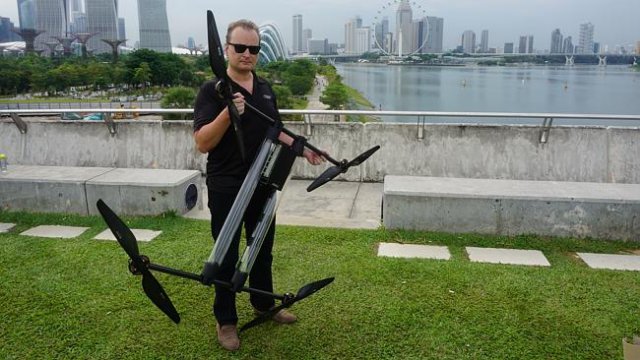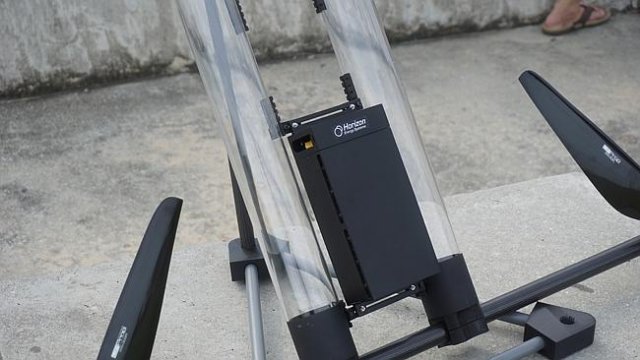Electrically powered quadcopters typically fly 15-20 minutes but Singapore-based Horizon Energy Systems’s (HES) CEO Taras Wankewycz is hoping that his team of fuel cell scientists and engineers will change all that.
Horizon Energy Systems’s hydrogen-powered hycopter can already fly for two hours, and Mr Wankewycz is hopeful of four hours by year’s end.
The HES team is aiming to have the hycopter ready for testing by year’s end and in market after that. Australia is very much in their sights.
“It’s very possible that we’ll sell our first units to a pretty large operator in Australia for things like railroad and road inspection,” Mr Wankewycz said.
Mr Wankewycz is also an executive director of HES’s parent firm Horizon Fuel Cell Technologies, which began working in the general hydrogen fuel cell space 12 years ago, and cut his teeth working for Eastman Chemical.
“We started with educational science kits way back then, and we kept perfecting the technology,” he said.
One early invention, a 6-inch long toy car called the H-racer, was featured by Time Magazine in its list of best inventions in 2006. “I think our company sold close to a million fuel cells because of our science education initiatives.”
Horizon’s first hydrogen-powered aircraft made its inaugural flight the same year. It has been producing fixed-wing unmanned aerial vehicles (UAVs), typically used in defence and aerospace, with hydrogen fuel cells for five years. Consumer hydrogen fuel cells with USB ports designed to power smartphones and other devices sell on Amazon.com in the US for about $US100.
Horizon is not alone in this venture with automakers and the US Army keenly developing them. But it’s the challenge of quadcopters that inspires Mr Wankewycz and he said his firm hands down makes the lightest fuel cells in the world.
“They’re 3 to 4 times lighter than a lithium battery. It gives us a unique advantage in the drone world. Drones are typically powered by lithium batteries but they don’t last that long.”
The fuel cells work by taking stored hydrogen and mixing it with air to produce water and electricity. According to Mr Wankewycz, the most efficient system for drones was to use batteries (charged by fuel cells) for peak power and energy surges and use fuel cells directly for continues lower power.
“It’s just like in a hybrid car,” he said.
With the hycopter scheduled for completion by year’s end, HES is in talks with drone operators and manufacturers.
In the UAV area, Horizon had worked with manufacturers in Israel, the US, Europe and India. “We work mainly with those who have been in business for many years; we’ve been working with the pioneers in drone manufacturing development, typically fixed wing aircraft.”
“This whole commercial space is just about emerging. There’s the inspection of all kinds of infrastructure, roads, railroads, pipelines, anything that’s a straight line over very large territory.
“But our technology is pretty expensive, it’s not consumer technology, although now our costs are starting to reduce and the commercial space is growing.”
To enhance efficiency, the hycopter stores its hydrogen within the drone’s structure. It is encased in carbon fibre. Wankewycz cites 180-200 watt hours per kilo as the energy output of lithium cells compared to 700 watt hours per kilo for hydrogen cells on his drone. The total hydrogen gas stored is 180 to 200 grams, equivalent of 5 to 6kg of lithium batteries.
Long-range drones used, in the Afghanistan war for example typically are powered by combustion engines, but it’s getting more from cheap electrical powered drones that will make them useful in natural disasters, monitoring road traffic, border patrols, agriculture, and antipoaching.
He said the hycopter fuel cell setup wasn’t really designed for hobbyist, rather for serious commercial applications. He said Australia’s remote areas were “an ideal setup”. “It’s not a consumer product, it’s a high performance product, somewhere between commercial and military.
Safety of course is a major concern with hydrogen — rocket fuel, but he said the technology today was safe. “We’ve been making it safe for years.” When asked if a hycopter could explode, he said: “the blades will kill you first”.
Hyundai this year unveiled its first hydrogen fuel cell car in Australia in April.- a Hyundai ix35 fuel cell powered car. It’s already on the road in the US, Canada, and Germany. In Australia the biggest limitation is the existence of just one fuel cell refuelling station — for now.
The technology has a major advantage over dedicated electric cars — refuelling time. A hydrogen fuel cell car can be refuelled in about the same time as petrol car offering a similar range.
Wankewycz cited three ways to replenish drone fuel cells. The most conventional way was to use industrial hydrogen bottle gas “just like you’d fill up a balloon”. In the field there was electrolysis, where you split water to get oxygen and hydrogen, or reforming of alcohol to a methanol-water blend.
It delivers a kilowatt hour per litre of alcohol.
He said preventing poaching was one of the good uses of drones. “We have a team of guys in South Africa operating a wildlife reserve over 70,000 hectares of land detecting poaching of rhinoceros and elephants for their horns. They’ve been deploying UAVs and all kinds of other sensors on the ground such as radar, to create an awareness canopy over very large territory.”
He said nobody had attempted a multi rotor drone with hydrogen fuel cell technology before.
“The reason we’re able to do that is because we can put hydrogen gas in the frame, we use the frame as storage, that’s the reason we’re able to lift off, but we’re not able to lift a huge weight.
“The best we’ll be able to do is to lift 6kg, so we can take a 1kg maximum payload, given the weight of the frame is 5kg.”
He said that to maximise energy efficiency, commercial quadcopters may evolve to be a hybrid of a fixed-wing aircraft and quadcopter. They would take off vertically with rotors and in the air use level flight
“We think that’s an area we will develop. In a fixed wing aircraft you have natural lift from the wings. When you’re cruising you’re only using 20 per cent of your maximum power.”
Source: The Australian Business Review



No body never saw it fly.
This company from Canada already flies and got proof for 2:15 hours on fuel cells.
https://www.youtube.com/watch?v=oIpXBJteYLE